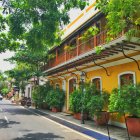Related articles
-
 Experience Bliss and Enjoyable Moments in the Shangri La that is Pawna Lake:Be Close to Nature Enjoy & Fun Filled Activities (2022)
Experience Bliss and Enjoyable Moments in the Shangri La that is Pawna Lake:Be Close to Nature Enjoy & Fun Filled Activities (2022)
-
 Embark on a Journey to Discover India. Your Guide to the Best Places to Visit in India in Every Season (2020)
Embark on a Journey to Discover India. Your Guide to the Best Places to Visit in India in Every Season (2020)
-
 समुद्र तट, प्रकृति का जादुई सौंदर्य, अनूठा आकर्षण सब कुछ है - पांडिचेरी यात्रा के दौरान वहाँ क्या देखें, क्या खाएं, कहां खरीदारी करें: पांडिचेरी में घूमने के 10 सर्वश्रेष्ठ स्थान (2020)
समुद्र तट, प्रकृति का जादुई सौंदर्य, अनूठा आकर्षण सब कुछ है - पांडिचेरी यात्रा के दौरान वहाँ क्या देखें, क्या खाएं, कहां खरीदारी करें: पांडिचेरी में घूमने के 10 सर्वश्रेष्ठ स्थान (2020)
Ahmedabad City
Ahmedabad is the former capital and the largest city of Gujarat. Established by the Islamic Ruler, Ahmed Shah in 1411 AD, this city also known as Amdavad; has a population of more than eight million and is spread in an area of 466 sq. km. The city has the famous 371 km long Sabarmati River flowing through the city and dividing it into two distinct parts: the eastern and western region respectively. The eastern and western parts of Ahmedabad are connected by nine bridges built on the Sabarmati River. The eastern part is called Old Ahmedabad and has the main railway station, the main post office and some old buildings of the Mughal and British era. Whereas, the western part, also known as New Ahmedabad is home to educational institutions, residential high rise buildings, shopping malls and multiplexes, etc.
Ahmedabad was ranked as the best city to live in India as per The Times of India Survey in 2012. Also, UNESCO has accepted the invitation to provide Ahmedabad the status of ‘World Heritage City’. Ahmedabad houses some of the best educational institutions like IIM Ahmedabad, National Institute of Design (NID), Physical Research Laboratory (PRL), Ahmedabad Textile Industry's Research Association (ATIRA) and the Centre for Environmental Planning and Technology (CEPT) to name just a few.
Culture and Traditions
Ahmedabad is a multicultural city and celebrates many festivals with fervour and enthusiasm. Popular celebrations include ‘Uttarayan’ - the annual kite flying festival on the 14th and 15th of January. The nine nights of 'Navratri' are celebrated with people playing Garba and Dandiya dances. Men and women are dressed in shimmery clothes and they take Dandiya sticks and dance on the tunes of Gujarati folk music.
Like other parts of the country, Diwali is also celebrated with joy and excitement and the people decorate their houses with lamps, make Rangoli on the floor and light firecrackers. The annual Rath Yatra procession taken out from the Jagannath Temple and the Tajia procession taken out by the Muslim community during the month of Muharram are also considered important festivals in Ahmedabad. Consumption and sale of liquor is totally banned in Gujarat.
Cricket is very popular in Ahmedabad and the Sardar Patel Stadium, Motera near Ahmedabad, expected to be completed by January, 2020, will be the world’s largest stadium with a seating capacity of more than 1,10,000 viewers. Ahmedabad is surely going to register its name on the world's Cricket Map.
Best Time to Visit
During the months of November to February is the winter season in Ahmedabad and the best time to visit as the weather is pleasant and the temperature hovers between 12 to 35 degrees. But, be careful to take your winter clothes as evenings are a bit chilly. April and May are pretty warm months and the mercury crosses the 40 degrees mark, but this time is ideal for getting good deals on the hotel tariffs.
Famous Dishes
Ahmedabad is home to many popular Gujarati dishes. Some of the famous snacks which you can enjoy at road-side stalls or regular restaurants are Khakra, Dhokla, Kulfi, Paani Puri, Dal Vada, Maska Bun with tea, Momos, Samosa, Stuffed Paranthas, Bhuna Gosht, Jalebi, Mutton Chap, Bhelpuri and Ice Gola. Apart from these, the regular Gujarati Thali which is a huge and full meal can be found in popular restaurants and makes for a scrumptious dinner or lunch.
Places of Historic Importance in Ahmedabad
Ahmedabad has a rich history of over a 1,000 years; in the 11th century it was known as Ashaval, when Karna, the Chalukya ruler of Anhilwara descended upon the city and defeated the Bhil king of Ashaval. King Karna established a city named Karnavati on the banks of the river Sabarmati. Then from the 13th to 14th century, Gujarat was ruled by the Vaghela dynasty of Dholka and from the 14th century, the Delhi Sultanate took control of Gujarat.
But, by the early 15th century the local Rajput Muslim Governor by the name of Zafar Khan Muzaffar, declared himself separate from the Delhi Sultanate and named himself as Muzaffar Shah I and became the self proclaimed Sultan of Gujarat. In 1411, his grandson Ahmed Shah was given charge of the entire Gujarat area. Ahmed Shah liked the forested area near Sabarmati and laid the foundation of a new walled city near Karnavati for his Capital on 26 Feb 1411. He named it Ahmedabad in the honour of four saints in the area who were collectively called Ahmed. However, few historians believe that he named the city on his own name.
Sabarmati Ashram
Sabarmati Ashram is also known as Gandhi Ashram or Satyagraha Ashram, is situated in a suburban area called Sabarmati near Ahmedabad. This place was the residence of Mahatma Gandhi and his wife Kasturba during the pre-independence era. Gandhiji commenced the famous ‘Dandi March’ from this Ashram and to express gratitude for the impact that the Dandi March had on the freedom movement of India, the Indian Government has recognised this place as a national monument.
There is a museum called ‘Gandhi Smarak Sangrahalaya’ which has a few of Gandhiji’s handwritten letters and photographs displayed inside this building, which was built in 1963. There are a few other buildings in the Ashram named after the people who were close to Gandhiji and his ideology such as Nandini, Upasana Mandir, Vinoba Kutir, etc. The entire Ashram can be explored in 1.5 to 2 hours and remains open between 8:30 a.m. to 6:30 p.m. for the general public.
Bhadra Fort
This huge fort built by Ahmed Shah in 1411 is spread over 44 acres and is one of the most important cultural heritages well preserved by the Archaeological Survey of India (ASI). It is said that the Bhadra Fort was named after the Goddess Bhadrakali, whose temple is situated inside the fort. The fort also houses a beautiful palace, gardens and a mosque as well, which adds to the charm of this ancient fort. The palace has a fortified wall with fourteen towers, eight gates and two large open areas where meetings were held by Kings and courtesans.
The Fort is an attraction for photographers as it has beautiful and minute carvings, frescoes and latticework which add to the grandeur of this place. On the eastern side of the fort is the famous ‘Teen Darwaja’ or triple door, which was an entrance to the Royal Square named as Maidan Shah. The Bhadra Fort is square shaped and almost 162 houses are built inside this massive structure. It was renovated by the ASI and Ahmedabad Municipal Corporation in 2014 as a cultural hub for the city.
Sardar Vallabhbhai Patel National Museum
Dedicated to the 1st Deputy Prime Minister of India, Sardar Vallabhbhai Patel; this Museum and Memorial is situated inside Moti Shahi Mahal at Shahibaug. This Museum was established in the 1978 by Mr. Babubhai Jasbhai Patel, the then Hon. Chief Minister of Gujarat. The Museum was later modified in 2013 and it showcases belongings and artefacts of Sardar Patel’s life and also has two halls where visitors can see the various aspects of the life and work of Sardar Patel through multimedia means like 3D sound, light and laser shows. This multimedia show is the first of its kind in India and the story of the freedom struggle of India is narrated beautifully with the help of modern technology.
Architectural Marvels in Ahmedabad
Being a 1,000 year old city, Ahmedabad has a rich cultural heritage and boasts of many architectural marvels which are an epitome of culture and beauty. A visit to Ahmedabad is incomplete without witnessing these ancient places.
Dada Hari Vav
Also known as Dada Harir Step-well, this famous step-well was built in the year 1499 AD by a household lady Dhai Harir of Sultan Begada (the then ruler of Gujarat) and Dhai Harir was also the caretaker of the Royal Harem. The name Dhai Harir has changed to Dada Hari over the ages and hence this name now.
The walls of the well have two inscriptions, one in Sanskrit and the other one in Arabic on the south and north walls respectively. The stairs are built in the Solanki architectural style in sandstone and are of octagonal shape at the top. The well is five stories deep and all the stories have enough space where dozens of people can easily stand. You can notice the intricate drawings on the walls, beams, arches and pillars of different gods and also some Islamic architecture is imbibed in them.
Jhulta Minar
It is one of the most amazing architectural wonders which has amused and puzzled the world for ages. Jhulta Minar or Swinging Tower has two identical towers connected through a passage. The unsolved mystery however is that if one minaret is shaken, the other also starts swinging and no prizes for guessing that no vibrations or energy passes through the connecting passage. This five hundred year old architecture is the pride of Sakar Bazaar area of the city.
As per beliefs, Sultan Ahmed Shah built this Mosque (of which the Minarets are a part of) in 1452, but was later destroyed in 1753 during a war between the Marathas and the Khans of the Gujarat Sultanate. Another theory states that the Mosque was built by a noble in the court of Md. Begada by the name of Malik Sarang and it was constructed in 1511 or later. Due to the demolition of the mosque, all the names and dates, etc. engraved on the minarets have disappeared and hence it is difficult to appropriately determine the correct history of this structure.
Sidi Saiyyed Mosque
Also famous as Sidi Saiyyed Ni Jaali, which means the net of Sidi Saiyyed; this is a world famous architecture for the history lovers and the photographers. This mosque was built in 1573 by Sidi Saiyyed, a royal slave in the army of the last Sultan Shams-ud-Din Muzaffar Shah III of the Gujarat Sultanate. The architecture of the mosque is entirely arch based and the minutely carved latticework windows (nets carved out of marble stone) on the side and rear arches are an exquisite example of elegant and unique artwork. All the windows have different designs in geometrical, tree shaped and palm motif, etc.
Famous Temples in Ahmedabad
Ahmedabad, with almost 80% of Hindu population is home to some very popular and divine temples. Thousands of visitors and devotees visit these temples every year to pray and experience divine bliss and seek spiritual guidance. Let’s check some of the most popular temples in Ahmedabad.
ISKCON Temple
Also known as the Hare Krishna Temple, this temple is dedicated to Lord Krishna. What differentiates this temple from the other temples is the peaceful ambience and calm atmosphere, where one can meditate or just sit quietly and experience heavenly bliss. One can always hear the chanting of ‘Hare Rama, Hare Krishna’ inside the temple. The architecture of temple is as beautiful from inside as it is mesmerising from the outside.
Swaminarayan Temple
Shri Swaminarayan Temple (famously known as Akshardham Temple) is a temple dedicated to God Narayan Dev and was built in 1822 by the efforts of Shri Swaminarayan (founder of the Swaminarayan sect of Hinduism). This Swaminarayan Temple stands tall in the Kalupur area of Ahmedabad. The temple has beautiful carvings on the outside which displays the architecture of the 19th century and inside the sanctum are the deities decorated with splendid ornaments and ethnic fabrics. A multistory guest house and a medical clinic for the convenience of the visitors are also inside the temple vicinity.
Hathisingh Jain Temple
This Jain Temple is dedicated to the fifteenth Tirthankara of Jains, named Dharmanath. This beautiful two storied marble shrine is visited by millions of visitors every year and is considered as a holy place for devotees from all over the world. The temple has a huge courtyard which is surrounded by rows of enchanting pergolas with 52 exquisitely designed and carved shrines. This temple presents an architectural model of the Dilwara Jain Temples of Rajasthan and is named after Shri Hathi Singh.
Bonus Tip for Best Family Time
The Sabarmati Riverfront and Law Garden Night Market - Sabarmati Riverfront is a tourist place developed on the banks of the river Sabarmati. The riverfront project was initially started as an environmental improvement program and was later extended to a tourist spot. This place has beautiful parks, open sitting places and plazas to entertain people visiting the Sabarmati Riverfront.
Related articles
-
 Experience Bliss and Enjoyable Moments in the Shangri La that is Pawna Lake:Be Close to Nature Enjoy & Fun Filled Activities (2022)
Experience Bliss and Enjoyable Moments in the Shangri La that is Pawna Lake:Be Close to Nature Enjoy & Fun Filled Activities (2022)
-
 Embark on a Journey to Discover India. Your Guide to the Best Places to Visit in India in Every Season (2020)
Embark on a Journey to Discover India. Your Guide to the Best Places to Visit in India in Every Season (2020)
-
 समुद्र तट, प्रकृति का जादुई सौंदर्य, अनूठा आकर्षण सब कुछ है - पांडिचेरी यात्रा के दौरान वहाँ क्या देखें, क्या खाएं, कहां खरीदारी करें: पांडिचेरी में घूमने के 10 सर्वश्रेष्ठ स्थान (2020)
समुद्र तट, प्रकृति का जादुई सौंदर्य, अनूठा आकर्षण सब कुछ है - पांडिचेरी यात्रा के दौरान वहाँ क्या देखें, क्या खाएं, कहां खरीदारी करें: पांडिचेरी में घूमने के 10 सर्वश्रेष्ठ स्थान (2020)
-
 If You are Planning a Trip to Pondicherry in 2020, These are the Places to Visit for Foodies, Beach Bums and Shopaholics!
If You are Planning a Trip to Pondicherry in 2020, These are the Places to Visit for Foodies, Beach Bums and Shopaholics!
-
 Sweep Your Girl Off Her Feet With the 10 Best Birthday Gifts for Girlfriend in 2018
Sweep Your Girl Off Her Feet With the 10 Best Birthday Gifts for Girlfriend in 2018
Ahmedabad - A Melting Pot of Cultures, Cuisines, History, Colours and Much More
We hope you would have liked this comprehensive guide - The Top-10 Places to Visit in Ahmedabad. Apart from these places, there are a plethora of other options; but we have tried to pick the best of attractions out of all those gems.